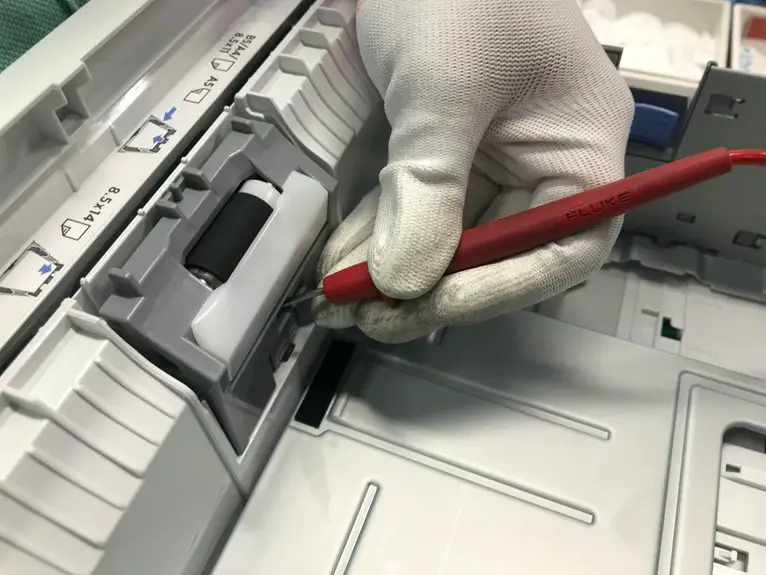As a home worker, you know that a malfunctioning printer can derail your productivity. It's essential to have some troubleshooting tips at your fingertips to quickly address common issues. From checking ink levels to handling paper jams, knowing what to do can save you time and frustration. Plus, understanding how to maintain your printer can prevent problems before they arise. Let's explore the key steps you should take to keep your printer running smoothly.
Key Takeaways
- Regularly check ink levels and paper supply to avoid interruptions during printing tasks.
- Ensure your printer is connected to Wi-Fi and powered on before sending print jobs.
- Restart both the printer and computer to resolve temporary connectivity or performance issues.
- Clean printer nozzles and perform maintenance tasks to maintain print quality over time.
- Keep a record of error messages to aid in troubleshooting specific printer problems effectively.
Identifying Common Printer Problems
When your printer starts acting up, it can be frustrating, especially if you rely on it for important tasks.
First, check for simple issues like a low ink level or a missing paper tray. If your printer won't connect, ensure it's properly plugged in and connected to your Wi-Fi network. You might also want to restart the printer and your computer to clear temporary glitches.
If you're hearing strange noises, that could indicate a mechanical issue. Error messages on your screen can provide clues, so pay attention to those.
Lastly, if the printer isn't producing clear prints, it might need a head cleaning or alignment. Identifying these common problems can save you time and stress.
Resolving Paper Jams Effectively
Although paper jams can be frustrating, resolving them effectively is often straightforward. First, turn off your printer and unplug it. Open the paper tray and carefully pull out any jammed paper, ensuring you remove all bits. Check the rollers for debris or damage, as these can cause further jams.
Here's a handy table to help you remember key steps:
| Step | Action |
|---|---|
| Turn Off Printer | Unplug and power down your printer. |
| Remove Jammed Paper | Gently pull out any stuck paper. |
| Check Rollers | Inspect for debris or wear. |
Fixing Connectivity Issues
After tackling paper jams, you might find yourself facing connectivity issues with your printer.
First, check if your printer is powered on and properly connected to your computer or network. If you're using Wi-Fi, ensure your printer is connected to the same network.
Restart both your printer and router to reset any temporary glitches. If it still doesn't connect, try reinstalling the printer driver on your computer. Sometimes, outdated drivers cause issues.
Make sure your firewall or antivirus isn't blocking the printer connection, as these can interfere. Lastly, check for any firmware updates for your printer, as these can also resolve connectivity problems.
With these steps, you'll likely restore your printer's connection and get back to work.
Correcting Print Quality Issues
If your prints come out streaked, faded, or with strange colors, it's time to address those quality issues.
First, check your ink or toner levels; low levels can lead to poor print quality. If they're fine, perform a print head cleaning through your printer's settings. This can often clear up streaks and improve color accuracy.
Next, ensure you're using the right paper type for your prints; using plain paper for photo prints can lead to disappointing results.
You should also check the print settings on your computer, as incorrect settings can affect output quality.
Lastly, keep your printer's nozzles and rollers clean to prevent dust and debris from interfering with the print process.
Maintaining Your Printer for Optimal Performance
To keep your printer running smoothly and producing high-quality prints, regular maintenance is key. Start by cleaning the printer's exterior and interior to prevent dust buildup.
Check and replace ink or toner cartridges as needed, ensuring you're using high-quality supplies. Run the printer's built-in maintenance functions, like print head cleaning and alignment, to enhance performance.
Regularly update the printer's software and drivers to ensure compatibility with your devices. Don't forget to check paper quality and storage; use the right type and keep it in a dry place to avoid jams.
Finally, keep an eye on printer usage and schedule professional servicing if you notice persistent issues. With these steps, you'll extend your printer's life and efficiency.
Frequently Asked Questions
How Can I Reset My Printer to Factory Settings?
To reset your printer to factory settings, locate the setup menu on the printer's display. Choose "Settings," then select "Factory Reset" or "Restore Defaults." Confirm your choice, and your printer will restart with original settings.
What Should I Do if My Printer Won't Turn On?
If your printer won't turn on, check the power source and connections. Ensure it's plugged in securely and try a different outlet. If it still won't work, consider replacing the power cord or contacting support.
How Often Should I Replace Printer Ink Cartridges?
You should replace printer ink cartridges when they're low or after every few hundred pages, depending on usage. Regular checks help maintain print quality, so keep an eye on your ink levels to avoid interruptions.
Can I Use Third-Party Ink Cartridges Safely?
You can use third-party ink cartridges, but be cautious. They might save you money, yet sometimes cause issues with print quality or damage your printer. It's best to research brands and read reviews before purchasing.
How Do I Clean My Printer's Print Head?
To clean your printer's print head, turn off the printer, remove the cartridges, and use a soft cloth with distilled water. Gently wipe the print head, then let it dry before reinserting the cartridges.
